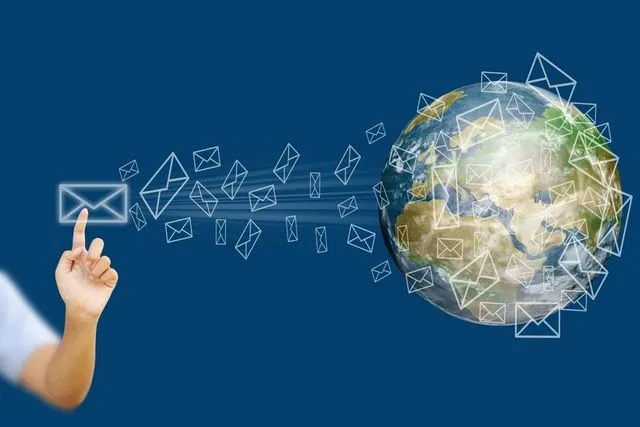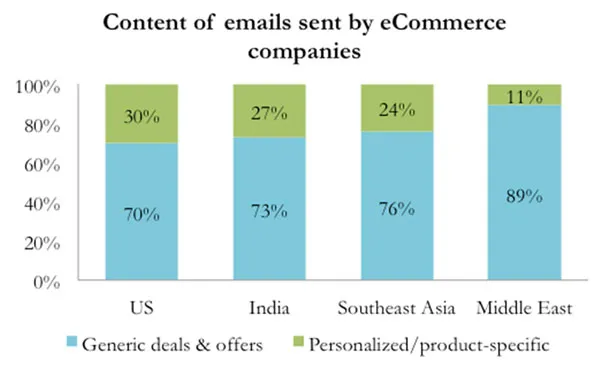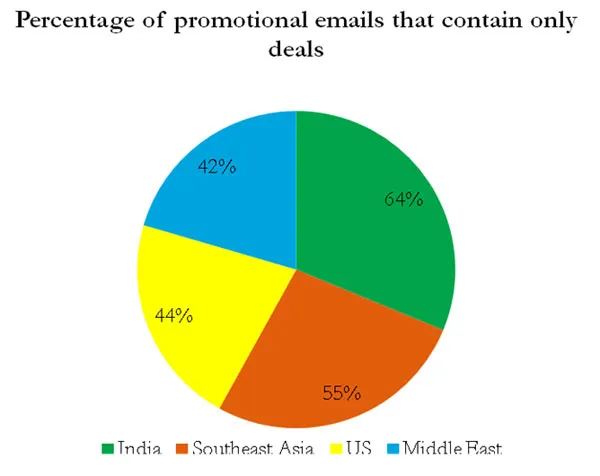Are e-commerce companies overdoing the deals and discounts in email marketing?
Globally, e-commerce players have understood the potential of email marketing, with many using it to boost their sales and customer loyalty. With automated email marketing, bulk emails containing the latest news about bestsellers, new arrivals and deals can be sent to customers. This has been honed over the years to ensure that just the right content is shared with the right customers, and at the right time. In fact, a study in 2014 found that revenue from email has increased proportionately by 28 per cent in one year.

We at TargetingMantra studied multiple online stores across geographies to test their email marketing and noticed that e-stores in the US, Middle East, Southeast Asia and India, despite being in varying stages of maturity, are following some of the same rules and not making optimum use of email marketing.
The parameters studied were:
- Content of Emails
- Reliance on Deals and Discount Coupons
- Level of Personalization in Emails
Content of emails
The need for relevant, personalised recommendations in each email you send to your customers cannot be stressed enough. The inbox is an individual’s personal space. Irrelevant banners with deals and promo codes that have nothing to do with the individual’s areas of interest will never work in a company’s favour.
Our studies revealed that most emails from e-commerce companies contain generic deals.
As you can see from the graph below, this trend is seen across geographies:

Clearly, personalisation is not given its due priority by most e-commerce players. In the Middle East, especially, a whopping 89 per cent of all emails sent by e-commerce companies to their customers comprise generic deals and offers. US e-stores fare somewhat better with 30 per cent emails dedicated to personalised and/or product-specific content, but there is still a long way to go to reap the full benefits of email marketing.
What are your customers really looking for?
Do you pause to consider what your customers would like to see in their inbox before you send them emails?
E-shoppers across the world are voicing their annoyance at receiving deals and promo offers in their inbox that have nothing to do with their preferences. In our survey, 69 per cent of customers said that emails they received from e-commerce companies were mass marketing ones that they ignored. About 23 per cent of the customers said that they found marketing emails irritating and marked such emails as spam. A very small proportion (eight per cent) of customers felt that the emails they received were personalised to their taste.

Over 70 per cent of e-shoppers have expressed annoyance at their inbox being flooded with promotional ‘junk’. The one-size-fits-all mantra does not work here. You must ensure that each email you send is specifically tailored to your customers’ needs. Only this will make you stand out from the rest.
Personalisation is a simple tool that uses information gathered from multiple data points, and is useful in pleasing customers and ensuring a good ROI. It is, therefore, surprising that so many e-commerce players do not take this small but crucial element into consideration while sending emails to their customers.
Reliance on Deals and Discount Coupons
We just saw that most of the emails sent by e-commerce companies are generic deals and banners, with hardly any personalisation. However, we went one step further and studied what percentage of these were purely deals and how many focussed on showing at least their new arrivals and bestsellers. The results were shocking!
Indian e-stores lead with 64 per cent emails dedicated solely to deals and offers. The online stores of the Middle East, which we saw earlier had least personalisation in their emails, focus more on product-specific newsletters and other content of interest, apart from deals.
The following pie-chart shows a comparison between emails from e-stores of the four regions:

What should be your course of action?
We now understand that emails should contain personalised content and not generic deals and offers for all. Collecting data for personalisation is not all that difficult, but ought to be done meticulously. The following points should be kept in mind while engaging in email marketing:
- Know your customers – Every individual is unique and understanding your customer – what he is looking for, his favoured categories, how often he visits your e-store, at what time he is most likely to come online and check his mailbox, among myriad other factors - will help you send more personalised emails.
- Send only relevant content via email – This one is obvious. You want your email to mean something to your customer, to spike his interest and nudge him to return to the e-store and make a purchase. This can only be achieved by sending relevant content in each email.
- Send emails when they will be read – Another no-brainer. Emails sent at inappropriate times get buried and lost under other, newer emails, and are trashed by most recipients. We shall discuss this in detail in the full report.
- Send fewer emails – Some marketers feel that bombarding customers with a large number of emails would result in the recipient opening/reading at least some of them. The low cost of sending emails further encourages this view. This is one of the biggest errors! As you shall read in the complete report, there is a marked disparity between how many emails customers would like to receive from online stores and how many they are receiving. According to our studies, this greatly increases chances of marking the emails ‘spam’ and unsubscribing from further emails.
- Understand which emails work for whom – Some customers are enticed by Abandoned Cart email, some by Discount Vouchers, some by Post-purchase Recommendation emails and so on. There are multiple types of emails and customers can be divided into segments based on who responds best to which type of email.
To download the complete email marketing research report by TargetingMantra – click here







